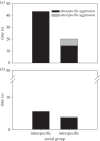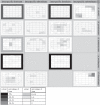Cohabitation promotes high diversity of clownfishes in the Coral Triangle
- PMID: 27030417
- PMCID: PMC4822472
- DOI: 10.1098/rspb.2016.0277
Cohabitation promotes high diversity of clownfishes in the Coral Triangle
Abstract
Global marine biodiversity peaks within the Coral Triangle, and understanding how such high diversity is maintained is a central question in marine ecology. We investigated broad-scale patterns in the diversity of clownfishes and their host sea anemones by conducting 981 belt-transects at 20 locations throughout the Indo-Pacific. Of the 1508 clownfishes encountered, 377 fish occurred in interspecific cohabiting groups and cohabitation was almost entirely restricted to the Coral Triangle. Neither the diversity nor density of host anemone or clownfish species alone influenced rates of interspecific cohabitation. Rather cohabitation occurred in areas where the number of clownfish species exceeds the number of host anemone species. In the Coral Triangle, cohabiting individuals were observed to finely partition their host anemone, with the subordinate species inhabiting the periphery. Furthermore, aggression did not increase in interspecific cohabiting groups, instead dominant species were accepting of subordinate species. Various combinations of clownfish species were observed cohabiting (independent of body size, phylogenetic relatedness, evolutionary age, dentition, level of specialization) in a range of anemone species, thereby ensuring that each clownfish species had dominant reproductive individuals in some cohabiting groups. Clownfishes are obligate commensals, thus cohabitation is an important process in maintaining biodiversity in high diversity systems because it supports the persistence of many species when host availability is limiting. Cohabitation is a likely explanation for high species richness in other obligate commensals within the Coral Triangle, and highlights the importance of protecting these habitats in order to conserve unique marine biodiversity.
Keywords: amphiprion; anemonefish; biodiversity; coral reefs; mutualism; symbiosis.
© 2016 The Author(s).
Figures




Similar articles
-
Phylogenetic relationships among the clownfish-hosting sea anemones.Mol Phylogenet Evol. 2019 Oct;139:106526. doi: 10.1016/j.ympev.2019.106526. Epub 2019 May 31. Mol Phylogenet Evol. 2019. PMID: 31158486
-
Host use drives convergent evolution in clownfish.Proc Natl Acad Sci U S A. 2025 Apr 29;122(17):e2419716122. doi: 10.1073/pnas.2419716122. Epub 2025 Apr 25. Proc Natl Acad Sci U S A. 2025. PMID: 40279387
-
Insights into the Genomics of Clownfish Adaptive Radiation: Genetic Basis of the Mutualism with Sea Anemones.Genome Biol Evol. 2019 Mar 1;11(3):869-882. doi: 10.1093/gbe/evz042. Genome Biol Evol. 2019. PMID: 30830203 Free PMC article.
-
Coral gardens: paternity and drug testing on the reef.Curr Biol. 2005 Jul 26;15(14):R544-5. doi: 10.1016/j.cub.2005.07.008. Curr Biol. 2005. PMID: 16051159 Review.
-
Never, Ever Make an Enemy… Out of an Anemone: Transcriptomic Comparison of Clownfish Hosting Sea Anemone Venoms.Mar Drugs. 2022 Nov 23;20(12):730. doi: 10.3390/md20120730. Mar Drugs. 2022. PMID: 36547877 Free PMC article. Review.
Cited by
-
Ontogenetic and phylogenetic simplification during white stripe evolution in clownfishes.BMC Biol. 2018 Sep 5;16(1):90. doi: 10.1186/s12915-018-0559-7. BMC Biol. 2018. PMID: 30180844 Free PMC article.
-
Anemonefishes: A model system for evolutionary genomics.F1000Res. 2023 Oct 27;12:204. doi: 10.12688/f1000research.130752.2. eCollection 2023. F1000Res. 2023. PMID: 37928172 Free PMC article. Review.
-
Host identity and symbiotic association affects the taxonomic and functional diversity of the clownfish-hosting sea anemone microbiome.Biol Lett. 2020 Feb;16(2):20190738. doi: 10.1098/rsbl.2019.0738. Epub 2020 Feb 5. Biol Lett. 2020. PMID: 32019466 Free PMC article.
-
The chromosome-scale genome assembly of the yellowtail clownfish Amphiprion clarkii provides insights into the melanic pigmentation of anemonefish.G3 (Bethesda). 2023 Mar 9;13(3):jkad002. doi: 10.1093/g3journal/jkad002. G3 (Bethesda). 2023. PMID: 36626199 Free PMC article.
-
Higher ultraviolet skin reflectance signals submissiveness in the anemonefish, Amphiprion akindynos.Behav Ecol. 2022 Nov 1;34(1):19-32. doi: 10.1093/beheco/arac089. eCollection 2023 Jan-Feb. Behav Ecol. 2022. PMID: 36789393 Free PMC article.
References
-
- Liem KF. 1980. Adaptive significance of intra- and interspecific differences in the feeding repertoires of cichlid fishes. Am. Zool. 20, 295–314. (10.1093/icb/20.1.295) - DOI
Publication types
MeSH terms
LinkOut - more resources
Full Text Sources
Other Literature Sources
Research Materials

